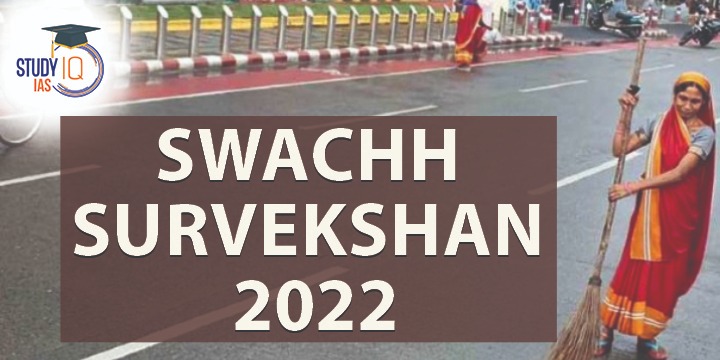Table of Contents
About the Swachh Survekshan
- Swachh Survekshan is an annual survey of cleanliness, hygiene and sanitation in villages, cities and towns across India.
- Swachh Survekshan was launched in 2016 by the Ministry of Housing and Urban Affairs (MoHUA) as a part of the Swachh Bharat Abhiyan.
- Swachh Survekshanis a competitive framework to encourage cities to improve the status of urban sanitation while encouraging large scale citizen participation.
- Over the years, Swachh Survekshan emerged as the largest urban sanitation and cleanliness survey in the world.
Important Highlights from the Swachh Survekshan 2022
- Cleanest city awards for Swachh Survekshan
| Category | Top Performers |
| More than one lakh population | 1) Indore, Madhya Pradesh (sixth time in a row)
2) Surat, Gujarat 3) Navi Mumbai, Maharashtra |
| Less than one lakh population | 1) Panchgani, Maharashtra
2) Patan, Chhattisgarh 3) Karad, Maharashtra |
| Safai Mitra Suraksha | Tirupati |
| Best Ganga town with more than one lakh population | Haridwar, Uttarakhand |
| Fast mover city | Shivamogga, Karnataka |
| India’s first 7-star Garbage Free city certification | Indore |
| 5-star Garbage Free certification | Surat, Bhopal, Mysuru, Navi Mumbai, Vishakhapatnam, and Tirupati |
- Cleanest state awards for Swachh Survekshan
| Category | Top Performers |
| More than 100 Urban Local Bodies | 1) Madhya Pradesh
2) Chhattisgarh 3) Maharashtra |
| Less than 100 Urban Local Bodies | 1) Tripura
2) Jharkhand 3) Uttarakhand |
Other Important Highlights of Swachh Survekshan
- Swachh Survekshan 2022 saw an unprecedented number of citizens’ feedback – over 9 crores, compared to 5 cores last year.
- Smaller cities with population of less than 25,000 have performed admirably towards transforming the urban landscape.
- The number of Star rated cities has gone up to 412 (with 11 five-star cities, 182 three-star cities, and 218 one-star cities), thus signifying how cities’ aspirations towards becoming Garbage Free is getting enhanced.
About the Star Rating Protocol of Garbage Free Cities
- Objective: It was launched by the MoHUA in 2018 to institutionalize a mechanism for cities to achieve Garbage Free status, and to motivate cities to achieve higher degrees of sustainable cleanliness.
- Parameters:
- It assesses cities across 23 different components of Solid Waste Management (SWM) and is graded based on overall marks received.
- It is based on 12 parameters which follow a SMART framework – Single metric, Measurable, Achievable, Rigorous verification mechanism and Targeted towards outcomes.
- Significance: The performance of cities under the Star Rating Protocol is crucial as it carries significant weightage for their final assessment in Swachh Survekshan.
- Goal: The star rating conditions have been designed in a way as to enable cities to gradually evolve into a model (7-star) city, with progressive improvements in their overall cleanliness.
About Swachh Bharat Mission – Urban 2.0 (SBM-U 2.0)
- Launch:
- It was announced in the Union Budget 2021-22, is the continuation of SBM-U first phase.
- SBM-U first phase was launched on 2nd October 2014 aiming at making urban India Open Defecation Free (ODF) and achieving 100% scientific management of municipal solid waste.
- Time period & outlay: It will be implemented over five years from 2021 to 2026 with an outlay of Rs.1.41 lakh crore.
- Objectives:
- It focuses on complete faecal sludge management, source segregation of garbage, reduction in single-use plastic and air pollution, by effectively managing waste from construction and demolition activities and bioremediation of all legacy dump sites.
- Under this mission, all wastewater will be treated properly before it is discharged into water bodies, and the government is trying to make maximum reuse a priority.


 Serious Fraud Investigation Office (SFIO...
Serious Fraud Investigation Office (SFIO...
 Article 142 of Indian Constitution, Sign...
Article 142 of Indian Constitution, Sign...
 Pakistan-Occupied Kashmir (PoK): History...
Pakistan-Occupied Kashmir (PoK): History...





















